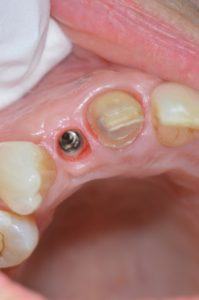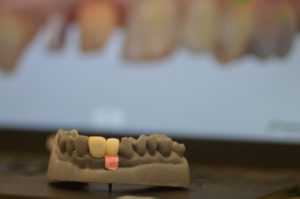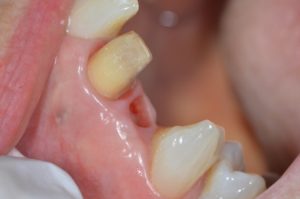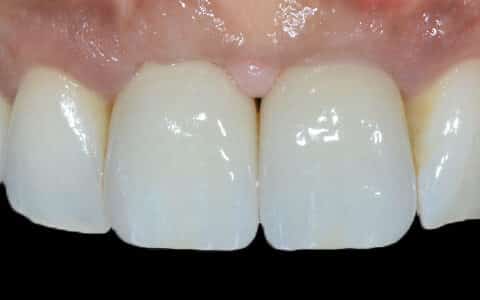I have been publishing weekly blogs since June 2016. My blogs have consisted of content designed to inform and educate patients and also dental professionals. Sometimes, readers of our blog get in touch with questions or comments and one of our blog readers has found the information on advanced dental procedures, such as dental implants, very helpful for her to enhance her understanding of certain dental procedures.
This blog is for my blog reader (and patient) who decided to have treatment to replace her missing upper lateral incisor with a dental implant. She will know who she is and I’m sure my readers understand that due to respect for patient confidentiality, I will not be revealing the identity of our patient.
Tooth loss due to a fractured crowned tooth
The patient had to contemplate losing the upper right lateral incisor because this tooth had a failing crown. Crowns can have a guarded long term prognosis due to the fact that the supporting tooth root may be heavily weakened following treatment with a crown, in particular if the tooth is already structurally weak such as a lateral incisor tooth.
Tooth replacement – Dental Implant
For our patient, the decision to have the tooth replaced with a dental implant was an easy one. She understood that this was the most effective way to replace her missing tooth with a functional and aesthetic replacement.
The planning stages involved a CBCT scan which enabled our team to accurately determine the anatomical area surrounding the upper right lateral incisor. With this information, the most suitable type and size of dental implant was selected and the precise location for the implant placement was carefully planned using the CBCT scan.
The tooth was removed and replaced with an immediate temporary bridge. Following tooth removal a titanium dental implant was placed in the missing tooth space, in the location that was planned on the CBCT scan.
The titanium implant is neatly hidden below the gum so that the titanium implant can integrate with the underlying bone. This is a biological process termed ‘osseointegration’ and it can typically take 3 months for this to occur. Once this process is complete to a suitable level, the implant is carefully exposed so a neat access hole is created in preparation for the tooth that will be fitted here.
A digital intra-oral scan is taken in the mouth to construct an accurate 3-dimensional digital replica of the patient’s mouth and implant. This information enables our team to design a carefully milled tooth which can be screwed onto the implant to complete the tooth replacement process. The tooth is carefully designed to fit into the patient’s existing smile so that the natural aesthetic appearance for the patient can be maintained.
Preventing further dental problems – Improving overall dental health
During this procedure, we also replaced the existing crown on the patient’s upper central incisor because it appeared to have a failing root canal filling and a poor marginal seal. By intervening before the tooth became worse, we were able to successfully treat the upper central incisor with a new root filling and a carefully milled ceramic crown. This new crown provides a much better seal around the tooth therefore, minimising the risk of further bacterial infiltration in the future.
To summarise, the treatment provided for our patient, and blog reader, enabled us to successfully save the upper central incisor and replace the upper lateral incisor. The patient was always well informed about each stage of her treatment and we feel this has significantly improved her dental health and dental aesthetics.
Thank you to all of the readers of my blog for their continued support. Leave a comment or send me an email if you would like the next blog on a particular topic…
Mohsin Patel BDS MJDF RCS (Eng)
Related articles...
Book a Consultation
At Infinity Dental Clinic we see patients for routine dental check-ups with our dentists. Regular dental maintenance and good oral hygiene will ensure that you keep your teeth and gums healthy.
Book a Consultation
















